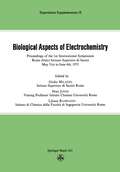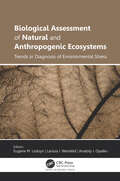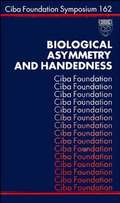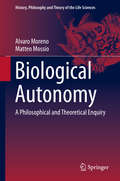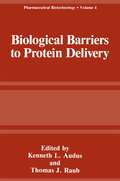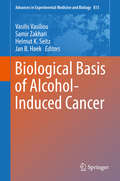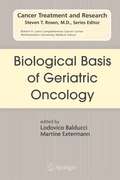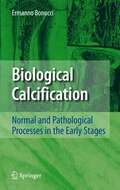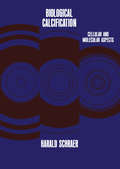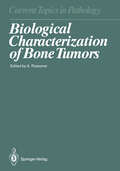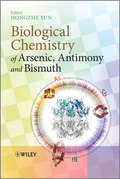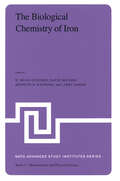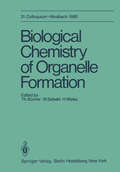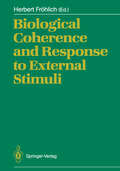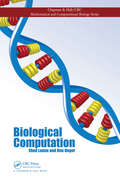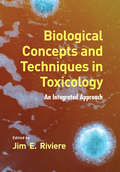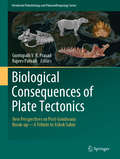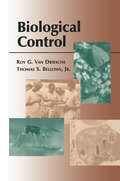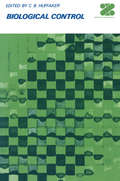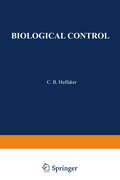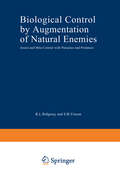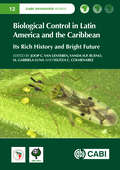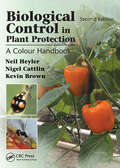- Table View
- List View
Biological Aspects of Electrochemistry: Proceedings of the 1st International Symposium. Rome (Italy) Istituto Superiore di Sanità, May 31st to June 4th 1971 (Experientia Supplementum #18)
by Milazzo Jones RampazzoBiological Assessment of Natural and Anthropogenic Ecosystems: Trends in Diagnosis of Environmental Stress
by Eugene M. Lisitsyn, DScThis new volume, Biological Assessment of Natural and Anthropogenic Ecosystems: Trends in Diagnosis of Environmental Stress, diverse methods and achievements in assessing the biological state of ecosystems are presented, biochemical, genetic and cytological methods are used, methodological achievements in this area are discussed in this volume. Experimental and practical aspects of the genetic diversity of cultivated plants and its application in modern business conditions are considered. The use of biological indicators for the purpose of protecting nature and practical application is presented. The authors of the book are biologists, biochemists, genetics, and ecologists from prestigious scientific institutions. This volume explores different types, different plant tissues and intracellular structures for the diagnosis and prediction of anthropogenic effects on living natural systems. Here, scientific information on the bioindication properties of living systems is presented and the theoretical foundations of its study are emphasized. This authoritative reference source will be a valuable addition for scientific researchers and students working in the field of biology, ecology, genetics, cytogenetics, agronomy and environmental assessment and its protection from anthropogenic destruction. The authors highlight the achievements, problems, and opportunities of biological methods for indicating the environment. Key features: Provides an overview of recent events and opportunities in the field of bioindication to control anthropogenic damage of living systems Considers the screening of new parameters to determine the health status of biological objects from one cell to an entire ecosystem, such as boreal peatlands Presents the results of a study of the response of plants to abiotic stressors Demonstrates the importance of role-related research of living objects as bioindicators Provides new research on various topics of plant resistance to stress Discusses design methodology, development and law of selection of indicators for specific environmental issues.
Biological Assessment of Natural and Anthropogenic Ecosystems: Trends in Diagnosis of Environmental Stress
by Eugene M. Lisitsyn Larissa I. Weisfeld Anatoly I. OpalkoThis new volume, Biological Assessment of Natural and Anthropogenic Ecosystems: Trends in Diagnosis of Environmental Stress, diverse methods and achievements in assessing the biological state of ecosystems are presented, biochemical, genetic and cytological methods are used, methodological achievements in this area are discussed in this volume. Experimental and practical aspects of the genetic diversity of cultivated plants and its application in modern business conditions are considered. The use of biological indicators for the purpose of protecting nature and practical application is presented. The authors of the book are biologists, biochemists, genetics, and ecologists from prestigious scientific institutions. This volume explores different types, different plant tissues and intracellular structures for the diagnosis and prediction of anthropogenic effects on living natural systems. Here, scientific information on the bioindication properties of living systems is presented and the theoretical foundations of its study are emphasized. This authoritative reference source will be a valuable addition for scientific researchers and students working in the field of biology, ecology, genetics, cytogenetics, agronomy and environmental assessment and its protection from anthropogenic destruction. The authors highlight the achievements, problems, and opportunities of biological methods for indicating the environment. Key features: Provides an overview of recent events and opportunities in the field of bioindication to control anthropogenic damage of living systems Considers the screening of new parameters to determine the health status of biological objects from one cell to an entire ecosystem, such as boreal peatlands Presents the results of a study of the response of plants to abiotic stressors Demonstrates the importance of role-related research of living objects as bioindicators Provides new research on various topics of plant resistance to stress Discusses design methodology, development and law of selection of indicators for specific environmental issues.
Biological Asymmetry and Handedness (Novartis Foundation Symposia #162)
by Gregory R. Bock Joan MarshExamines the progress of leading scientists working on various aspects of handedness in order to consider the occurrence of handedness in the biological world. Provides in-depth coverage of the origin and development of morphological asymmetry occurring in most types of living organisms.
Biological Autonomy: A Philosophical and Theoretical Enquiry (History, Philosophy and Theory of the Life Sciences #12)
by Alvaro Moreno Matteo MossioSince Darwin, Biology has been framed on the idea of evolution by natural selection, which has profoundly influenced the scientific and philosophical comprehension of biological phenomena and of our place in Nature. This book argues that contemporary biology should progress towards and revolve around an even more fundamental idea, that of autonomy. Biological autonomy describes living organisms as organised systems, which are able to self-produce and self-maintain as integrated entities, to establish their own goals and norms, and to promote the conditions of their existence through their interactions with the environment.Topics covered in this book include organisation and biological emergence, organisms, agency, levels of autonomy, cognition, and a look at the historical dimension of autonomy. The current development of scientific investigations on autonomous organisation calls for a theoretical and philosophical analysis. This can contribute to the elaboration of an original understanding of life - including human life - on Earth, opening new perspectives and enabling fecund interactions with other existing theories and approaches. This book takes up the challenge.
Biological Barriers to Protein Delivery (Pharmaceutical Biotechnology #4)
by Kenneth L. Andus Thomas L. RaubIn response to the tremendous increase in the number of protein and peptide drugs, this treatise critically reviews transport and metabolism mechanisms relating to the delivery of endogenous and recombinant proteins to mammalian organs, tissues, and cells. It will promote fruitful collaboration among academic and industrial scientists in the fields of pharmacology, cell biology, biochemistry, physiology, and immunology.
Biological Basis of Alcohol-Induced Cancer (Advances in Experimental Medicine and Biology #815)
by Vasilis Vasiliou Samir Zakhari Helmut K. Seitz Jan B. HoekIn the recent years, a significant amount of research has emerged connecting the link between alcohol and cancer. The field has rapidly advanced, especially since the complex connection between alcohol and cancer has several unique sub areas that are being investigated. This proceedings volume will contain chapters based upon the presentation of the 2nd International Conference on Alcohol and Cancer in Colorado, 2013. The various topics explore the affects of alcohol on: liver and breast cancer; cell signaling and cancer; stem cells; biomarkers and metabolomics; aerodigestive cancers; cancer and the immune system and more.
Biological Basis of Geriatric Oncology (Cancer Treatment and Research #124)
by Lodovico Balducci Martine ExtermannThis volume highlights research issues specific to geriatric oncology in the field of carcinogenesis and cancer prevention and treatment, based on the biologic interactions of cancer and age. It conveys a sustainable way of thinking about cancer and aging.
Biological Calcification: Normal and Pathological Processes in the Early Stages
by Ermanno BonucciFor the first time, this book offers a critical review of the calcification process of the organic and inorganic phases of mineralized tissues focusing on the earliest phases. It includes a methodological chapter which provides the necessary practical information for making appropriate choices. The book is set to become an important reference source for the shelves of bone densitometry labs across the world.
Biological Calcification: Cellular and Molecular Aspects
by Harald SchraerThe deposition of calcium-containing salts is a widespread phenomenon in both the plant and animal kingdoms. Its occurrence suggests a generalized biological adaptation to environments rich in calcium. Indeed, the Archaean ocean was rich in calcium carbonate, and traces of ancient organisms have been found in lime stones estimated to be about 2. 7 billion years old. The fundamental nature of biological calcification makes it a subject of interest not only to the student of calcium metabolism and skeletal physiology, but also to biologists in general. As in many areas of biological science recent progress in this field has been rapid, and no attempt was made here to cover all the biological systems in which calcifica tion is an important facet of the organisms' method of operation. Calcification is approached in this volume at the levels of the cellular sites and molecular mechan isms that are involved in this process. The ultrastructural and chemical features of the cells and their products which are associated with calcification are empha sized in several chapters. The editor, in inviting contributions from authors, in tended that collectively the chapters should convey a sense of the ubiquitous and essential nature of the role of calcification in several phyla of the plant and animal kingdoms. The researchers were biochemists, physical chemists, cell biologists and physiologists; some represented medicine and dentistry; all were interested in calcification.
Biological Characterization of Bone Tumors (Current Topics in Pathology #80)
by J. Althoff D.B.v. Bassewitz A. Bosse V. Bouropoulou J. J. Brooks W. Dierschauer G. Edel E. Grundmann A. Härle W. Hiddemann H. J. Höhling N. Jiang G. Jundt M. Kolve V. A. LiVolsi W. Mellin P. Quint A. Roessner A. Schulz F. Sim C. Sorg T. Spelsberg G. C. Steiner J. Q. Tojanowski E. Vollmer L. E. Wold P. Wuisman G. ZwadloDuring the past few years, a considerable number of monographs on bone tumors have been published. They are mainly restricted to bone tumors as clinical-pathological entities, since their diagnosis, more than that of other tumors, requires the interdisciplinary cooperation between orthopedic specialist, radiologist, and pathologist. However, investiga tions concerning the histogenesis of bone tumors are rather limited, although they might be helpful in explaining the unique morphological heterogeneity of tumors of the skeletal system. Furthermore, the histo genetic approach in the study of bone tumors may facilitate the inter pretation of the advanced cytobiological methods available for improv ing classification and diagnosis. Therefore, this volume presents recent pathological advances in the biological characterization of bone tumors. A major chapter deals with the differential diagnosis of Ewing's sarcoma as regards its demarcation from the so-called neuroectodermal tumor of bone. The analysis of the ground substances in bone-forming tumors may be helpful for their classification. Therefore the volume includes a chapter on the biochemical and histochemical analysis of different osteosarcoma types. Recently it has become clear that in addition to different collagen types which are not specific for bone tissue, several bone-specific proteins occur, one of which is osteonectin. Its distribu tion is obviously important for the classification and diagnosis of osteo blastic tumors. Proliferative behavior is of major importance for the diagnosis of malignant tumors.
Biological Chemistry of Arsenic, Antimony and Bismuth
by Hongzhe SunArsenic, antimony and bismuth, three related elements of group 15, are all found in trace quantities in nature and have interesting biological properties and uses. While arsenic is most well known as a poison - and indeed the contamination of groundwater by arsenic is becoming a major health problem in Asia - it also has uses for the treatment of blood cancer and has long been used in traditional chinese medicine. Antimony and bismuth compounds are used in the clinic for the treatment of parasitic and bacterial infections. Biological Chemistry of Arsenic, Antimony and Bismuth is an essential overview of the biological chemistry of these three elements, with contributions from an international panel of experts. Topics covered include: chemistry of As, Sb and Bi biological chemistry of arsenic biological chemistry of Sb and Bi arsenic and antimony speciation in environmental and biological samples arsenic in traditional chinese medicine arsenic in aquifers biomethylation of As, Sb and Bi uptake of metalloids by cells bismuth complexes of porphyrins and their potential in medical applications Helicobacter pylori and bismuth metabolism of arsenic trioxide in blood of the acute promyelocytic leukemia patients anticancer properties of As, Sb and Bi radio-Bi in cancer therapy genotoxicity of As, Sb and Bi metallomics as a new technique for As, Sb and Bi metalloproteomics for As, Sb and Bi Biological Chemistry of Arsenic, Antimony and Bismuth conveys the essential aspects of the bioinorganic chemistry of these three elements, making this book a valuable complement to more general bioinorganic chemistry texts and more specialized topical reviews. It will find a place on the bookshelves of practitioners, researchers and students working in bioinorganic chemistry and medicinal chemistry.
Biological Chemistry of Arsenic, Antimony and Bismuth
by Hongzhe Sun Jei-Fu ShawArsenic, antimony and bismuth, three related elements of group 15, are all found in trace quantities in nature and have interesting biological properties and uses. While arsenic is most well known as a poison - and indeed the contamination of groundwater by arsenic is becoming a major health problem in Asia - it also has uses for the treatment of blood cancer and has long been used in traditional chinese medicine. Antimony and bismuth compounds are used in the clinic for the treatment of parasitic and bacterial infections. Biological Chemistry of Arsenic, Antimony and Bismuth is an essential overview of the biological chemistry of these three elements, with contributions from an international panel of experts. Topics covered include: chemistry of As, Sb and Bi biological chemistry of arsenic biological chemistry of Sb and Bi arsenic and antimony speciation in environmental and biological samples arsenic in traditional chinese medicine arsenic in aquifers biomethylation of As, Sb and Bi uptake of metalloids by cells bismuth complexes of porphyrins and their potential in medical applications Helicobacter pylori and bismuth metabolism of arsenic trioxide in blood of the acute promyelocytic leukemia patients anticancer properties of As, Sb and Bi radio-Bi in cancer therapy genotoxicity of As, Sb and Bi metallomics as a new technique for As, Sb and Bi metalloproteomics for As, Sb and Bi Biological Chemistry of Arsenic, Antimony and Bismuth conveys the essential aspects of the bioinorganic chemistry of these three elements, making this book a valuable complement to more general bioinorganic chemistry texts and more specialized topical reviews. It will find a place on the bookshelves of practitioners, researchers and students working in bioinorganic chemistry and medicinal chemistry.
The Biological Chemistry of Iron: A Look at the Metabolism of Iron and Its Subsequent Uses in Living Organisms Proceedings of the NATO Advanced Study Institute held at Edmonton, Alberta, Canada, August 13 – September 4, 1981 (Nato Science Series C: #89)
by B. H. Dunford D. Dolphin K. N. Raymond L. SiekerThe results of a NATO Advanced Study Institute (ASI) entitled "Coordination Chemistry Environments in Iron-Containing Proteins and Enzymes - Including Smaller Molecules and Model Systems" are summarized in this book. The ASI was held in the Province of Alberta, Canada, from August 23 to September 4, 1981. The first half of the conference was held on the campus of the University of Alberta, Edmonton, and the second half at the Overlander Lodge, Hinton. Two other conferences had the greatest impact upon the planning for this ASI. One was a NATO ASI held in Tomar, Portugal in September of 1979, entitled "Metal Ions in Biology". Among the organizers for that conference were Allen Hill and Antonio Xavier; we are happy to acknowledge their beneficial influence on our subsequent conference. The other most influential conference was one organized by Ralph Wilkins and Dennis Darnell entitled "Methods for Determining Metal Ion Environments in Proteins" which was held in Las Cruces, New Mexico, U.S.A., January 10-12, 1979. The Las Cruces conference invited lectures were published as Volume 2 of "Advances in Inorganic Biochemistry", G. Eichhorn and L. Marzilli, editors.
Biological Chemistry of Organelle Formation: 31. Colloquium, 14.-19. April (Colloquium der Gesellschaft für Biologische Chemie in Mosbach Baden #31)
by T. Bücher W. Sebald H. WeissEukaryotic cells contain a plurality of organelles distinguished by their specific membranes and contents. Their biogenesis occurs by growth and division of preexisting structures rather than de novo. Mitochondria and chloroplasts, which appear to be descended from prokaryotic ancestors, have retained some DNA and the biosynthetic capability for its expression. They synthesize, however, only a few of their proteins themselves. Most of their proteins are synthesized on free ribosomes in the cytoplasm and are only assembled in the correct membrane after synthesis is complete. The biogenesis of peroxisomes and glyoxysomes also appears to occur by an incorporation of proteins synthesized first in the cytoplasm. Other organelles, the Golgi complex, lysosomes, secretory vesicles, and the plasma membrane, are formed in a different manner. Their proteins are assembled in the membrane of the endoplasmic reticulum during trans lation by bound ribosomes and they must then be transported to the correct membrane. The 1980 Mosbach Colloquium was one of the first attempts to discuss the biogenesis of the various organelles in biochemical terms. This was appropriate since the crucial problems now center on the search for signals and receptors that dictate the site of assembly, the route taken, and the final location of a particular organelle protein. The assembly of prokaryotic membranes and the membrane of an animal virus were also discussed, since these simpler systems might shed light on the biogenesis of organelles in eukaryotes.
Biological Computation (Chapman And Hall/crc Mathematical And Computational Biology Ser.)
by Ehud LammThe area of biologically inspired computing, or biological computation, involves the development of new, biologically based techniques for solving difficult computational problems. A unified overview of computer science ideas inspired by biology, Biological Computation presents the most fundamental and significant concepts in this area. In the book
Biological Concepts and Techniques in Toxicology: An Integrated Approach
by Jim E. RiviereHighlighting the latest advances in molecular biology, mathematical modeling, quantitative risk assessment, and biopharmaceutical development, this reference presents how current scientific applications and methods impact and revolutionize mainstream toxicological research. Presenting findings from disciplines that will impact the future of toxicol
Biological Consequences of Plate Tectonics: New Perspectives on Post-Gondwana Break-up–A Tribute to Ashok Sahni (Vertebrate Paleobiology and Paleoanthropology)
by Guntupalli V. R. Prasad Rajeev PatnaikThis book recognizes and celebrates the contributions of Professor Ashok Sahni to the field of paleontology. Prof. Sahni established a School of Vertebrate Palaeontology at Panjab University, Chandigarh, India, where he trained many of today’s vertebrate paleontologists of India. The book covers topics on evolutionary patterns, macroevolutionary events, origination and radiation events, changes in physical environments & climate and their implications for biodiversity dynamics, intercontinental affinities and biogeographic connections in a plate tectonic framework. The book begins by exploring India in the age of the dinosaurs, discussing new fossil remains from the Jurassic Era, then moves through the Cretaceous and Eocene to provide a picture on faunal and floral changes in Gondwanaland in the context of plate tectonics. Furthermore, the book explores the evolutionary patterns and biotic dispersals that resulted from the northward drift of Indian plate during the Cretaceous and its collision with Asia in the Eocene. The respective chapters reveal the role of plate tectonics and climate in shaping the geographical distribution of plants and animals in Gondwana, specifically in India, as well as the post-India/Asia collision implications for biodiversity changes and biogeography in the region’s continental environments. Given its scope, the book will appeal to vertebrate paleontologists, evolutionary biologists, and paleobiogeographers.
Biological Control: An Introduction To Biological Control (pdf) (Thomas Say Monographs)
by Roy Van Driesche Thomas S. Bellows Jr.Biological Control
by C. HuffakerThe explosive increase in the world's human population, with conse quent need to feed an ever-increasing number of hungry mouths, and the largely resultant disturbances and pollution of the environment in which man must live and produce the things he needs, are forcing him to search for means of solving the first problem without intensifying the latter. Food production requires adequate assurance against the ravages of insects. In the last three decades short-sighted, unilateral and almost exclusive employment of synthesized chemicals for insect pest control has posed an enormous and as yet unfathomed contribution to the degradation of our environment, while our insect pest problems seem greater than ever. Properly viewed, pest control is basically a question of applied ecology, yet its practice has long been conducted with little regard to real necessity for control, and in some cases, with little regard to various detrimental side-effects or long-term advantage with respect, even, to the specific crop itself. This book deals fundamentally with these questions. The development of pesticide resistance in many of the target species, against which the pesticides are directed, has occasioned an ever-increasing load of applications and complexes of different kinds of highly toxic materials. This has been made even more "necessary" as the destruction of natural enemies has resulted, as a side effect, in the rise to pest status of many species that were formerly innocuous. The application of broad-spec trum pesticides thus has many serious and self-defeating features.
Biological Control: Proceedings of an AAAS Symposium on Biological Control, held at Boston, Massachusetts December 30–31, 1969
by C. HuffakerThe explosive increase in the world's human population, with conse quent need to feed an ever-increasing number of hungry mouths, and the largely resultant disturbances and pollution of the environment in which man must live and produce the things he needs, are forcing him to search for means of solving the first problem without intensifying the latter. Food production requires adequate assurance against the ravages of insects. In the last three decades short-sighted, unilateral and almost exclusive employment of synthesized chemicals for insect pest control has posed an enormous and as yet unfathomed contribution to the degradation of our environment, while our insect pest problems seem greater than ever. Properly viewed, pest control is basically a question of applied ecology, yet its practice has long been conducted with little regard to real necessity for control, and in some cases, with little regard to various detrimental side-effects or long-term advantage with respect, even, to the specific crop itself. This book deals fundamentally with these questions. The development of pesticide resistance in many of the target species, against which the pesticides are directed, has occasioned an ever-increasing load of applications and complexes of different kinds of highly toxic materials. This has been made even more "necessary" as the destruction of natural enemies has resulted, as a side effect, in the rise to pest status of many species that were formerly innocuous. The application of broad-spec trum pesticides thus has many serious and self-defeating features.
Biological Control by Augmentation of Natural Enemies: Insect and Mite Control with Parasites and Predators (Environmental Science Research #11)
by R. RidgwayThe protection of agricultural crops, forest, and man and his domestic animals from annoyance and damage by various kinds of pests remains a chronic problem. As we endeavor to improve pro duction processes and to develop more effective and acceptable tactics for achieving this protection, we must give high priority to all potentially useful techniques for the control and management of insects. Pest control is recognized as an acceptable and necessary part of modern agriculture. Methods employed vary greatly and tend to reflect compromises involving 3 determining factors: technological capability, economic feasibility, and social acceptability. How ever, these factors are also subject to change with time since each involves value judgments that are based on available information, cost, benefit considerations, the seriousness of the pest problem, and the political climate. Whatever method is chosen, energy resources continue to dwindle under the impact of increasing popu lation, and it is inevitable that greater reliance must be placed upon renewable resources in pest management. One alternative is the use of a pest management method that uses the energy of the pest's own biomass to fuel a self-perpetuating control system. The use of biological control agents for the control of pests has long been an integral part of the pest management strategy in crop production and forestry and in the protection of man and animals. The importance and unique advantages of the method are well recognized; numerous treatises deal with accomplishments and methodologies.
Biological Control in Latin America and the Caribbean: Its Rich History and Bright Future (CABI Invasives Series)
by Hugo César Arredondo-Bernal Jorge L. Sifontes Anobel Barba Lorena Barra-Bucarei César Basso Wagner Bettiol Fermin Blanco Helga Blanco-Metzler Claudia Carolina Antúnez Guillermo Cabrera Walsh Carmen C. Castillo Charlotte E. Causton Ronald D. Cave Edwin E. Sosa Patricia Castillo Willy Chiaravalle Ximena Cibils Dr Matthew Cock Alba Marina Cotes Luis V. Crespo Luis Devotto Moreno Francisco Ferrer Andrés France Iglesias Javier P. Franco Fermín Fuentes Fernando Gallardo-Covas Patricio G. Gallegos Victor Adolfo López Nancy M. Greco Lidcay Herrera Leopoldo Hidalgo Wendy-Ann P. Isaac Maitrie Jagroep Ayub Khan Takumasa Kondo Maria R. Manzano Maria Elena Marquez Jose Morales Sanchez Rossy Morera-Montoya Norma Mujica Jose Roberto Parra Alelino Pitty Karina Punschke Mayra Ramos Olgaly Ramos-Rodriguez Gloria Resquin Romero Adela Ribeiro Mayra G. Rodriguez Beatriz Rodriguez-Velez Phillipe Ryckewaert Colmar Serra Michelle A. Sherwood Rogelio Trabanino Alies Van Sauers-Muller Carlos Vasquez Jean-Francois Vayssieres Luis L. Vazquez Mary Whu Bruno ZachrissonThe book summarizes the history of biological control in Latin America and the Caribbean. Few publications provide historical detail and the records are, therefore, fragmented until now. By bringing information together in this book, we offer a more complete picture of important developments in biological control on this continent. There are a wealth of text, tables and references about the history of such projects, and which were successful and which failed. This will help plan future biocontrol projects. An overview is provided of the current situation in biological control for many Latin American and Caribbean countries, revealing an astonishing level of practical biological control applied in the region, making it the largest area under biological control worldwide. The final part describes new developments and speculates about the future of biological control in Latin America and the Caribbean.
Biological Control in Plant Protection: A Colour Handbook, Second Edition
by Neil Helyer Nigel D. Cattlin Kevin C. BrownThere has been a large increase in the commercial use of integrated crop/pest management methods for pest and disease control on a wide range of crops throughout the world since the first edition of this book. The completely revised second edition of the bestselling Biological Control in Plant Protection: A Color Handbook continues the objective of
